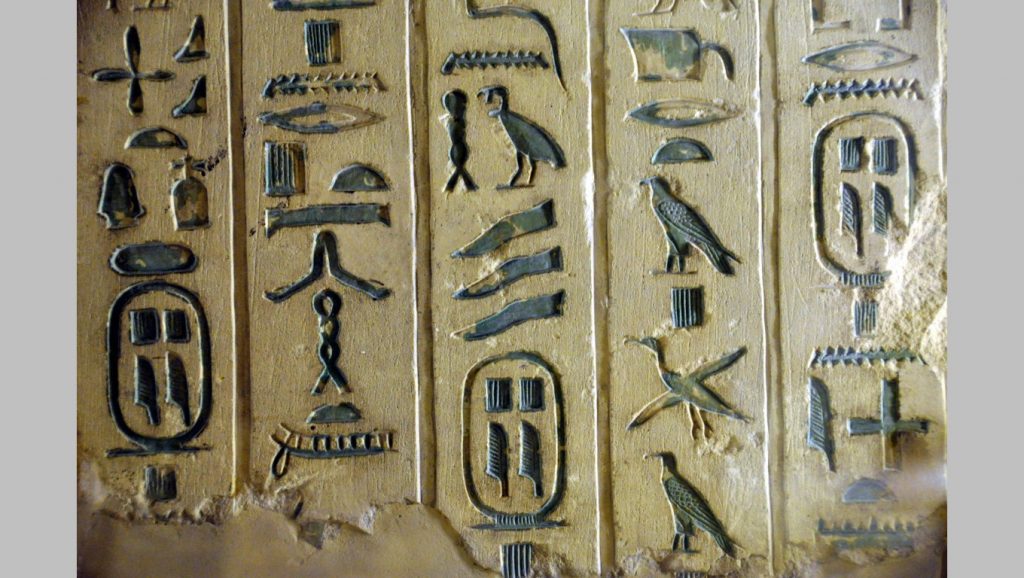The Pyramid Texts are a collection of funerary inscriptions written on the walls of nine Fifth and Sixth Dynasty pyramids (generally dated to around 2350 B.C.E).

The earliest known version of the texts is from the pyramid of Unas, but it is generally thought that the texts were already very old at that time. It is often suggested that they were composed around 3000-3100 B.C.E, making them the oldest sacred texts in the world. For example, Utterances 273-4 (also known as the Cannibal Hymn) refer to a funerary cult that predates the pyramids (thought to have been constructed around 2500-2560 B.C.E).
There are around 760 spells but none of the pyramids contain a full set of spells and some are duplicates. The most complete set can be found in the pyramid of Pepi II whose collection contains 675 “utterances”. The spells are known as utterances because each section begins with the phrase “words to be spoken” (except the text in Unas pyramid in which the phrase only appears at the beginning of the text). The language is fairly archaic and includes redundant terminology.
The texts also include the earliest example of retrograde writing (where the figures of animals and people face the wrong way – i.e. they do not indicate the direction of the text as they normally do). Also many of the figures of animals and people have been left incomplete, to limit their power and prevent them from harming the deceased pharaoh.

It is not clear whether they were intended to be read in a specific order and there seems to be no relationship between the content of each utterance and its position in relation to the cardinal points of the compass.
The texts describe the afterlife, and the resurrection of the pharaoh. In some texts, the pharaoh travels on the sun barque with Ra, while in others the king flies to heaven in the form of a falcon or a goose or climbs up a ladder to reach the sky.
Whatever their differences, all texts agree that the deceased king lives again in the sky with the sun-god Ra and the imperishable stars of the night sky. The aim of the text is to help the king in this journey by invoking the assistance of a number of deities. This assistance is necessary partly because of the large number of evil forces who inhabit the afterworld.

The texts also include the first reference to the “opening of the mouth” ceremony which was a central part of the mummification ritual throughout Egyptian history.
The texts assert the prime position of Ra, but also form the first reference to the god Osiris as the ruler of the underworld. They describe how Osiris is murdered by Set and resurrected by Isis, Nephthys, and Horus. The texts also reference to the continuous battle between Horus and Set.
Three fairly distinct theologies are merged together in the texts; the stellar theology led by Horus the Elder in which the pharaoh becomes a star in the heavens; the stellar/ lunar theology in which the pharaoh as Osiris travels through underworld; and the solar theology in which the pharaoh becomes one with the sun god, Ra.
The first two theologies were easily synchronized when Horus the Elder was to some degree absorbed by Horus son of Isis. However, the slightly uneasy alliance between the solar theology of Ra and the stellar theology of Horus / Osiris is still very apparent.
It is thought that the scribes of Heliopolis were the first to compose texts describing their philosophy but that even before the construction of the pyramids the Osirian myths had been introduced into their theology (the Ennead). By the time the texts were inscribed within the pyramids, this merger had been underway for a considerable period of time, yet there is little evidence of the underworld as it normally appears in the Osirian myths. The bulk of the texts favour the solar religion.
The pyramid texts also contain references to the theology of Memphis (Sekhmet, Ptah, and Nefertum) and Hermopolis (Nun and Naunet, Heh and Hauhet, Kuk and Kuaket, Amun and Amaunet, Thoth and Anubis). The texts later evolved into the “Coffin Texts” and the “Book of the Dead”.
Bibliography
- The Complete Gods and Goddesses of Ancient Egypt (2003) Richard H. Wilkinson
- Egyptian Mythology (1997) Simon Goodenough
- The Ancient Egyptian Pyramid Texts (2005) James P Allen
- Gods of Ancient Egypt (1996) Barbara Watterson
Copyright J Hill 2015